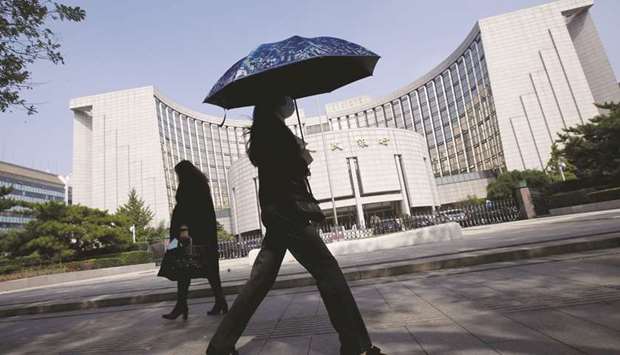Chinese banks extended far more new loans in December than expected, bringing last year’s tally to a record $2.4tn as Beijing scrambles to help cash-starved companies and ease mounting pressure on the weakening economy.
Analysts say Chinese policymakers need to spur faster credit expansion this year to galvanise activity as growth looks set to cool to near 30-year lows.
Chinese banks extended 1.08tn yuan ($159.95bn) in net new yuan loans last month, central bank data showed yesterday, much more than analysts had expected but down from 1.25tn yuan in November.
Analysts polled by Reuters had predicted a more modest reading of 800bn yuan, noting loan demand often softens at the end of the year.
For 2018 as a whole, China’s loan growth looked solid, with banks extending a record 16.17tn yuan in new loans – more than the gross domestic product of Italy.
The jump in full-year loans was a rare piece of good news for China after a troubled year marked by a trade war and record corporate defaults.
But several key credit gauges remained around record lows or fell to new ones, reinforcing views that conditions are likely to get worse before they get better.
The total was nearly 20% more than the previous all-time high in 2017, as Beijing ramped up efforts to turn around stubbornly weak credit growth and revive flagging investment.
Household loans accounted for 46% of 2018 new loans, down from the previous year’s 53%, while corporate loans accounted for 51% of the total, versus 50% in 2017, central bank data showed.
In addition to new loans, the trend has also been influenced by a regulatory crackdown on shadow lending that has forced banks to shift riskier loans back onto their books.
But that push started to weigh more heavily on the economy early in 2018, pushing up borrowing costs.
While new loans ended 2018 on a slightly more upbeat note, several other key credit gauges suggest overall credit conditions in China remain stubbornly tight despite the recent shift to policy easing.
Analysts say it will take at least a few quarters for the latest measures to turn that trend around.
Broad M2 money supply grew 8.1% in December from a year earlier, missing forecasts for a slight pick-up and hovering just above November’s record low.
Growth of outstanding total social financing (TSF) slowed to an all-time low of 9.8% from 9.9% in November, as regulators’ continued crackdown on riskier types of financing is slowly shutting off a major source of funding for smaller companies.
TSF includes off-balance sheet forms of financing that exist outside the conventional bank lending system, such as initial public offerings, loans from trust companies and bond sales.
As in past downturns, China has tried to stoke credit demand by fast tracking infrastructure projects, though such moves tend to benefit larger companies which are often state controlled.
They have also been regularly injecting funds into the financial system to keep financial conditions supportive and bring down market interest rates, especially for private firms which account for most of China’s urban jobs.
The People’s Bank of China said earlier this month it was cutting the amount of cash that banks have to hold as reserves for the fifth time in the past year, freeing up another $116bn for new lending.
But government efforts to channel more funds to the struggling private sector are facing a hurdle as banks are wary of more bad debts.
Commercial banks’ non-performing loan ratio climbed to a 10-year high in 2018.
Some cash-strapped companies may be taking advantage of lower borrowing costs to refinance, but with sales and earnings weakening many businesses are in no mood to make the new investments that Beijing is counting on to turn the economy around.
A branch manager in eastern China said banks want to lend, but companies were very cautious.
“Corporate demand is little. Good assets are scarce and hard to find.”
Oxford Economics forecasts overall credit growth will pick up by around 1 percentage point to roughly 11% by the end of this year, as the central bank’s various lending facilities gradually foster a return of business confidence.
Analysts say Beijing will have to keep up a steady stream of fiscal and monetary stimulus to stabilise the world’s second-largest economy, with most not expecting it to bottom out till summer.
Further hefty reductions in banks’ reserve requirements are expected this year, and a few market watchers say the odds are rising of interest rate cuts in some form.
“We continue to expect the 7-day repo rate to move moderately lower in the coming months to buffer the growth slowdown, as well as quarterly RRR cuts in the rest of H1,” analysts at Goldman Sachs said in a note.
However, most economists continue to believe that authorities will not resort to more aggressive easing measures such as a cut in benchmark lending rates.
While that would pressure banks to lower borrowing costs for all sizes of companies nationwide, policymakers are concerned it could weaken the yuan currency, spark capital outflows and add to a mountain of debt created by past stimulus sprees.

People walk past the headquarters of the People’s Bank of China in Beijing. Chinese banks extended 1.08tn yuan ($159.95bn) in net new yuan loans last month, central bank data showed yesterday, much more than analysts had expected but down from 1.25tn yuan in November.
